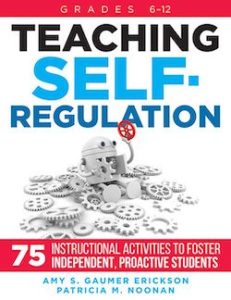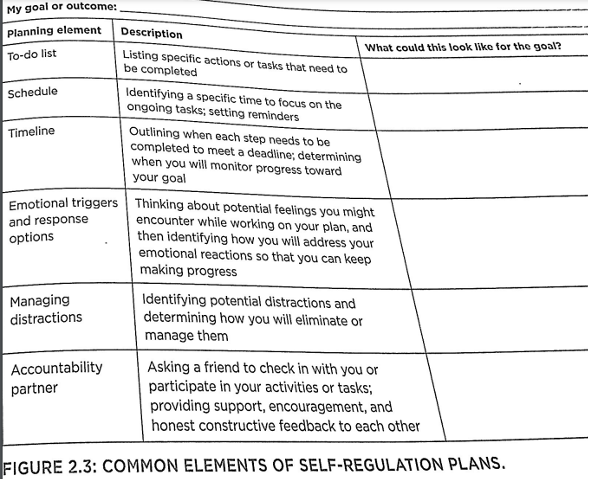75 Activities to Help Foster Self-Regulation
Teaching Self-Regulation: Seventy-Five Instructional Activities to Foster Independent, Proactive Students, Grades 6–12
By Amy S. Gaumer Erickson and Patricia M. Noonan
(Solution Tree Press, 2022 – Learn more)
Reviewed by Helene Alalouf

Are you spending too much time planning their projects and then you’re frustrated by students still missing work and deadlines?

Using their ideas for explicit instruction and authentic deliberative practice, supported by constructive feedback prompts for self-reflection and change, you can do this!
The practice scenarios – ordered from highly structured to independent, and building in subsequent chapters – cover homework completion, eating healthy, overcoming presentation anxiety, and writing research projects, to name a few.
Teachers may select and adjust the classroom-tested practices for their grade, context, and student population’s needs. Each chapter has an editable instructional planning form, and the Epilogue presents a system perspective for schoolwide implementation.
Lesson Structure
Through the three phases, responsibility is gradually shifted to the students to build competence.
- Initial instruction: Activities promote conceptual development, personal connections, shared vocabulary, and checks for understanding.
- Guided collaborative learning: Discussion about vignettes simulating adolescents’ experiences to expose perspectives, choices, strategies, and tools. Anchor charts and reminders that not all strategies work for everyone and heighten self-awareness and responsibility.
- Independent practice with feedback: Develop skills towards course-specific and general academic, social, emotional, or personal goals, with performance-based assessments.
Chapter Contents
- Understanding Self-Regulation
- Making a Plan
- Monitoring Your Plan and Progress
- Adjusting Your Plan
- Reflecting on Your Efforts and Outcomes
- Putting It All Together
- Measuring Growth in Self-Regulation
- Epilogue and Next Steps
Influence
Teachers and students’ reactions sprinkled throughout the chapters illustrate ways students can overcoming struggles. The authors also describe long-term benefits, such as:
“completing homework on time, doing better in their classes, feeling more in control of their learning and their upcoming tasks, getting better organized, managing their time effectively, learning more in their classes, figuring out specific reasons that they are struggling with something and directly addressing those challenges, and gaining a better understanding of how specific actions they take (or don’t take) have an impact on their progress and overall success.” (Gaumer Erickson & Noonan, 2019b) p. 28.
Developing effective plans is a worthy life skill. Instruction should build around these questions that can help ensure a good plan:
● How will I know I’ve successfully reached my goal? What does success look like?
● What are the steps, strategies, and actions necessary to accomplish my goal? When, where, and how will I work toward my goal?
● What could go wrong? How will I avoid or overcome these challenges?
● How will I track my progress? (p. 49)
The authors stress that student tracking and monitoring is more than checking off items on a list. “To effectively self-regulate after we create a plan, we must monitor both our actions (whether we are carrying out the plan as intended) and our progress toward meeting the objective” (p.55).
This example about grades will resonate with everyone:
“For instance, if I wanted to improve my grade in English class, but the only thing I’m monitoring is my grade (the progress toward my goal), then I’m not going to have enough information to help me make effective changes to reach my goal.
“Being aware of my grade is one piece of the puzzle, but it’s not the only thing I need to monitor. I also need to monitor the specific things that affect my grade. Am I regularly losing points for turning in late homework? Am I losing points because I’m not following instructions about assignments or because I’m not understanding the material? Am I losing points for talking in class or being tardy?
“These are actions that go into calculating my overall grade, and if I’m only checking on the grade and not analyzing how I’m doing on all those pieces, then I’m not going to be able to effectively identify and work on my problem areas. And I’m not likely to make progress toward improving my grade” (p. 61).
My Favorite Templates
One of my favorite templates was 2.3 Common Elements of Self-Regulation Plans because it included not only action elements but anticipated the need for fix-it strategies when obstacles arise.
Another favorite template was the 3.8 Homework Log. We all know the value of deliberate distributed practice; yet teachers shy away from the battle. Erickson and Noonan’s log is different from any tool I have ever tried because of the time management and chunking! The left side of the landscape chart is devoted to these Planning items:
- Class and Assignment
- Do I have all the material?
- Estimated Difficulty (1=Easy; 5=Hard) Do I need help?
- Do I need to break it into smaller pieces? If yes, add rows.
- Estimated time needed to complete.
The right half has two Monitoring sections, Actions and Progress:

Implement This Toolkit!
So whether you’re seeking activities and strategies for an advisory period or next Fall’s start of year academic preparation, consider collaborating with colleagues to implement this toolkit. Set up a free account to check out the free companion reproducible templates that accompany this book. Success is near!
Authors Amy Gaumer Erickson and Pattie Noonan recently wrote about Helping Middle Level Students Self-Regulate here at MiddleWeb.
Since attaining her Masters from Teachers College, Columbia University, and later National Board Certification, education consultant Helene Alalouf relishes opportunities to share her passion and informed fluency of research-evident principles to ensure a productive learning environment, cognitively and affectively, to support educators and families in realizing their vision. At leisure, she enjoys walking and cooking with family and friends, reading, and knitting.



































